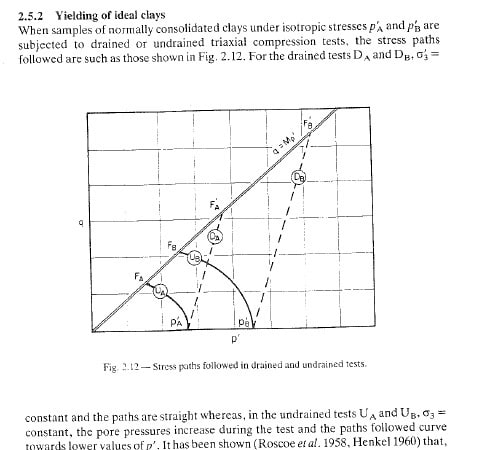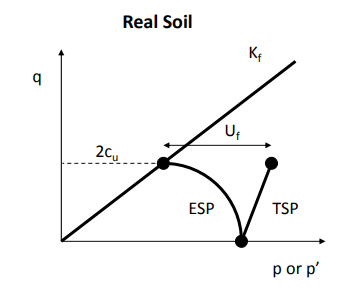Navigation
Install the app
How to install the app on iOS
Follow along with the video below to see how to install our site as a web app on your home screen.
Note: This feature may not be available in some browsers.
More options
Style variation
-
Congratulations MintJulep on being selected by the Eng-Tips community for having the most helpful posts in the forums last week. Way to Go!
You are using an out of date browser. It may not display this or other websites correctly.
You should upgrade or use an alternative browser.
You should upgrade or use an alternative browser.
NC Clay stress path
- Thread starter Kereo
- Start date
- Status
- Not open for further replies.
When estimating shear strengths for natural clays, drained strengths increase after a long time for natural deposits. End of construction / staged construction / operational loading is usually the condition to consider. The drained strength would lie as shown in leroueil.

The first stage of site investigation is desktop and it informs the engineer of the anticipated subsurface conditions. By precluding the site investigation the design engineer cannot accept any responsibility for providing a safe and economical design.

The first stage of site investigation is desktop and it informs the engineer of the anticipated subsurface conditions. By precluding the site investigation the design engineer cannot accept any responsibility for providing a safe and economical design.
The 'drained = effective' and 'undrained = total' may be a little confusing: you can have an undrained test with an effective stress path, for instance. Also, the key parameter for total stress analysis is the deviator stress, which is the same in effective stress and total stress space. I cannot see the application or relevance of a total stress path. I'm happy to be provided with examples of its relevance, if there are any.
It's also worth noting that, in the stress path image above, the total stress path will only ever start at the same point as the effective stress path if the total pore-water pressure is zero.
It's also worth noting that, in the stress path image above, the total stress path will only ever start at the same point as the effective stress path if the total pore-water pressure is zero.
While it's true you can use undrained shear strength tests to derive drained behavior, it requires pore pressures to figure out the drained behavior.
I'm sticking with my earlier statement. If effective strength is reported, that's what you'd use for drained behavior.
f-d
ípapß gordo ainÆt no madre flaca!
I'm sticking with my earlier statement. If effective strength is reported, that's what you'd use for drained behavior.
f-d
ípapß gordo ainÆt no madre flaca!
- Thread starter
- #6
Hey everyone, is there a reason for calling it "drained behaviour" when the undrained shear strength test forces the sample to fail in an undrained manner? I understand that in the test you can find the effective strength parameters through the pore pressure measured, but excess pore doesn't dissipate though.
I always thought that the total stress and effective stress behaviours in the undrained test determine undrained shear strength, which is shown as Ua/Ub in the figure above, and that the drained behaviour correlates to TSP line shown above, because NC clay gains strength after a very long time.
Thx
I always thought that the total stress and effective stress behaviours in the undrained test determine undrained shear strength, which is shown as Ua/Ub in the figure above, and that the drained behaviour correlates to TSP line shown above, because NC clay gains strength after a very long time.
Thx
Kereo said:Hey everyone, is there a reason for calling it "drained behaviour" when the undrained shear strength test forces the sample to fail in an undrained manner?
That's kind of my point about this 'drained = effective'/'undrained = total' stuff - it's misleading.
I understand that in the test you can find the effective strength parameters through the pore pressure measured, but excess pore doesn't dissipate though.
The pore pressure doesn't need to dissipate since drained or undrained you will always end up on the critical state line (CSL). Look up critical state soil mechanics for more information. Essentially it is a 3D space of e-p'-q; you are looking at the p'-q plane in the above example.
Further to my gripe above, I'd prefer the terms 'constant volume' and 'constant stress' to 'undrained' and 'drained', respectively. You'll see why when looking at critical state soil mechanics.
I always thought that the total stress and effective stress behaviours in the undrained test determine undrained shear strength, which is shown as Ua/Ub in the figure above, and that the drained behaviour correlates to TSP line shown above, because NC clay gains strength after a very long time.
As noted by others, under fully 'drained' shearing, the soil may go further than the undrained shear strength. Note: this might not be your failure stress path, however. I understand there to have been a number of dam failures due to a misunderstanding about the failure stress path. I don't know much more about that, however.
The 1:3 angle of the total stress path is the same as the drained effective stress path because one out of the three principal stresses are increasing while the other two are held constant. However, as I noted above, the total stress path only starts at the same point as the effective stress path if the total pore-water pressure is zero; otherwise it would start at a different mean total stress (p) value.
- Thread starter
- #8
Just wanted to provide illustration to LRJ's comment on critical state and e-q-p space to supplement the previous image shown from Leroueil Embankments on Soft Clay, Highly recommended resource for understanding clay behavior.

The first stage of site investigation is desktop and it informs the engineer of the anticipated subsurface conditions. By precluding the site investigation the design engineer cannot accept any responsibility for providing a safe and economical design.

The first stage of site investigation is desktop and it informs the engineer of the anticipated subsurface conditions. By precluding the site investigation the design engineer cannot accept any responsibility for providing a safe and economical design.
- Status
- Not open for further replies.
Similar threads
- Locked
- Question
- Replies
- 3
- Views
- 856
- Locked
- Question
- Replies
- 0
- Views
- 719
- Replies
- 4
- Views
- 522
- Replies
- 1
- Views
- 417
- Replies
- 11
- Views
- 897


![[bigsmile] [bigsmile] [bigsmile]](/data/assets/smilies/bigsmile.gif)